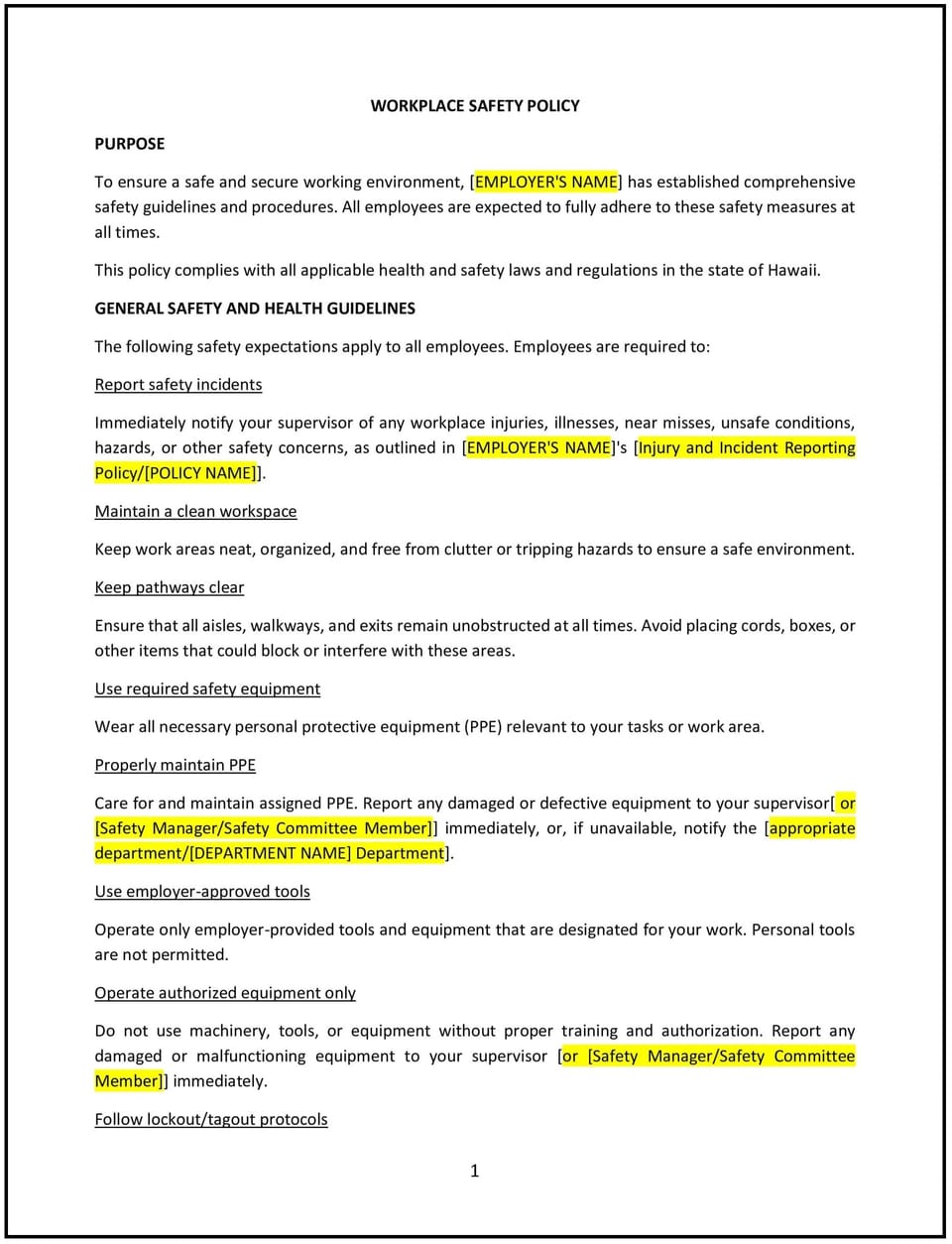Workplace safety policy (Hawaii): Free template

Workplace safety policy (Hawaiʻi)
A workplace safety policy helps Hawaiʻi businesses create a safe and healthy environment for employees, customers, and visitors. This policy outlines procedures for identifying hazards, preventing accidents, and responding to emergencies, while considering Hawaiʻi’s unique geographic and cultural context. It is designed to promote safety, reduce risks, and support the well-being of everyone in the workplace.
By implementing this policy, businesses in Hawaiʻi can protect their workforce, minimize disruptions, and demonstrate a commitment to safety and community values.
How to use this workplace safety policy (Hawaiʻi)
- Define safety responsibilities: Clearly outline the roles and responsibilities of employees, managers, and the business in maintaining a safe workplace.
- Identify hazards: Provide guidelines for identifying and addressing potential hazards, such as unsafe equipment, slippery floors, or hazardous materials.
- Establish safety procedures: Outline procedures for safe work practices, including the use of personal protective equipment (PPE) and proper handling of tools or machinery.
- Conduct regular inspections: Schedule routine safety inspections to identify and address risks before they lead to accidents.
- Provide training: Educate employees on safety protocols, emergency procedures, and the proper use of equipment and PPE.
- Develop emergency response plans: Create procedures for responding to emergencies, such as fires, natural disasters, or medical incidents.
- Communicate the policy: Share the policy with employees during onboarding and through internal communications to ensure awareness and understanding.
- Monitor and enforce the policy: Regularly review workplace safety practices and address any issues promptly and fairly.
- Review and update the policy: Periodically assess the policy’s effectiveness and make adjustments as needed to reflect changes in workplace dynamics or safety needs.
Benefits of using this workplace safety policy (Hawaiʻi)
This policy offers several advantages for Hawaiʻi businesses:
- Protects employees: Clear guidelines help prevent accidents and injuries, ensuring a safe environment for everyone.
- Reduces risks: Proactive measures minimize the likelihood of workplace incidents and their potential impacts on the business.
- Enhances productivity: A safe workplace allows employees to focus on their work without concerns about hazards or risks.
- Builds trust: A commitment to safety demonstrates the business’s care for employee well-being and fosters trust and loyalty.
- Aligns with cultural values: The policy reflects Hawaiʻi’s emphasis on community, respect, and caring for one another.
- Improves preparedness: Training and emergency response plans help employees and managers respond effectively to incidents.
- Supports compliance: The policy helps businesses align with safety best practices and local regulations.
Tips for using this workplace safety policy (Hawaiʻi)
- Communicate the policy effectively: Share the policy with employees during onboarding and through regular reminders, such as emails or training sessions.
- Provide training: Educate employees on safety protocols, emergency procedures, and the proper use of equipment and PPE.
- Encourage reporting: Create a safe environment where employees feel comfortable reporting hazards or safety concerns without fear of retaliation.
- Conduct drills: Practice emergency response plans, such as fire drills or evacuation procedures, to ensure employees know how to react during incidents.
- Be proactive: Address potential hazards promptly and encourage employees to take an active role in maintaining a safe workplace.
- Review the policy periodically: Update the policy as needed to reflect changes in workplace dynamics, safety needs, or legal requirements.
Q: Why should Hawaiʻi businesses adopt a workplace safety policy?
A: Businesses should adopt this policy to protect employees, reduce risks, and create a safe and healthy work environment.
Q: What are some common workplace hazards?
A: Common hazards include unsafe equipment, slippery floors, hazardous materials, and inadequate lighting or ventilation.
Q: How should businesses identify and address hazards?
A: Businesses should conduct regular inspections, encourage employees to report hazards, and take prompt action to address risks.
Q: What training should businesses provide to employees?
A: Businesses should educate employees on safety protocols, emergency procedures, and the proper use of equipment and PPE.
Q: How can businesses prepare for emergencies?
A: Businesses should develop emergency response plans, conduct regular drills, and ensure employees know evacuation routes and procedures.
Q: What should employees do if they notice a safety hazard?
A: Employees should report the hazard to a manager or supervisor immediately and avoid working in unsafe conditions.
Q: How often should businesses review the policy?
A: Businesses should review the policy annually or as needed to reflect changes in workplace dynamics, safety needs, or legal requirements.
This article contains general legal information and does not contain legal advice. Cobrief is not a law firm or a substitute for an attorney or law firm. The law is complex and changes often. For legal advice, please ask a lawyer.


